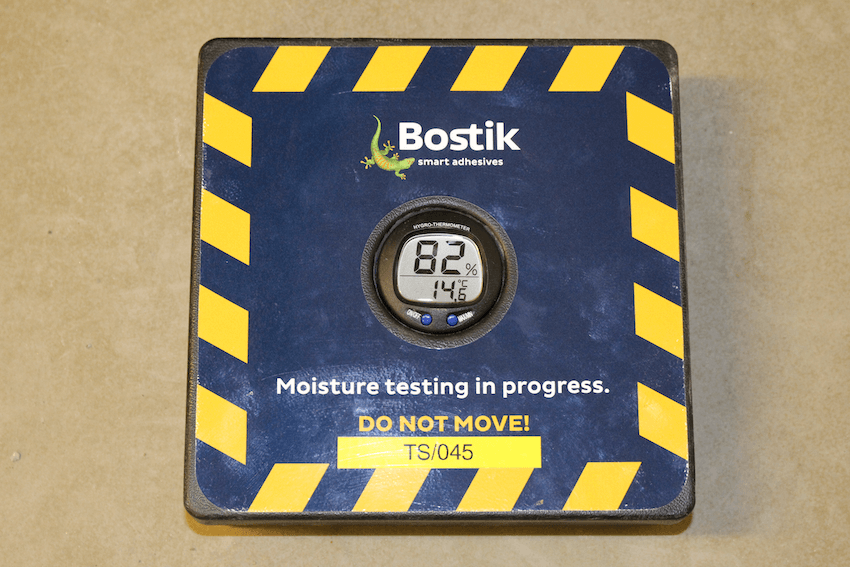Moisture testing is a crucial stage in the preparation of any new floor. These types of test are often offered by a manufacturer’s technical team, but it’s good to understand the most common ones carried out.
Why do we need to perform moisture tests? In the past, moisture was less likely to damage newly laid flooring. Some of the floor coverings used had high moisture vapour transmission rates (they were more breathable), while bitumen-based adhesives were relatively moisture-tolerant. However, today the most common types of floor coverings in modern buildings include materials like rubber and highly flexible vinyl, which have much lower moisture vapour transmission rates and despite their health and environmental benefits, some solvent-free adhesives do not tolerate moisture as effectively.
Additionally, construction practices have altered – in the past, buildings were put up relatively slowly, but today there is greater pressure for projects to move at a faster pace. Floor coverings are now laid very quickly, often when the subfloors still retain a large amount of residual moisture.
“Floor coverings are now laid very quickly, often when the subfloors still retain a large amount of residual moisture”
While surface-applied damp proof membranes (DPMs) can often be installed on floors that contain moisture, measuring and interpreting moisture levels is the best way to prevent failures. This will help you understand if a DPM needs to be applied and, if so, what type of product is required e.g. a two-part epoxy or a water-based acrylic.
There are several different moisture tests to measure the dryness of a new slab, with various pieces of equipment available on the market. While they are generally designed for new subfloors, they can be used on older ones too and are useful if you’re unsure whether or not a moisture barrier exists.
Hand-held pin meter or moisture encounter meter
There are two types of meter that use pins to measure moisture content. Devices like a pin meter or a moisture encounter meter instantly display a numerical reading that indicates the screed’s dryness. They can be used in several locations, enabling us to gain a greater understanding of the dryness of the slab throughout a site, and highlighting where the floors are most at risk.
The meter’s pins are pushed onto a clean area of a flat floor and held there. A pin meter is usually used to measure the wood moisture equivalent percentage in timber and will measure the top surface of a screed – only measuring about 1mm deep. It uses a traffic light system to indicate the moisture content. A moisture encounter meter, such as a Tramex meter, sends a signal deep into the floor. How deep will depend on the substrate, but it can be up to 19mm.
While these initial tests are not recognised as British Standards tests, carrying them out in multiple areas enables us to determine where to concentrate further moisture tests that are part of British Standards.
Hygrometer
A hygrometer is a non-invasive test that measures the amount of water vapour present in a subfloor, providing a relative humidity (RH) reading. A hygrometer box is sealed to the floor with putty or butyl tape and left in situ for 3 to 7 days. It will entrap air and moisture, and is left long enough for the moisture to reach a point of equilibrium.
Any moisture detected will be displayed on the hygrometer’s gauge or by connecting it to a meter. Some hygrometers can store historical data, such as the highest reading obtained during the testing period.
A hygrometer provides a %RH reading. British Standard BS-8203:2017 Annex B: states that a floor is dry enough to apply flooring when a hygrometer reading of 75%RH or lower is obtained for resilient floor coverings, and 65%RH or lower for timber floor installations.
Hygrometers will measure the %RH at the point they are placed. As the surrounding areas are open and breathing while the area beneath the hygrometer is not, hygrometers should be moved once equilibrium has been achieved – usually every few days.
Frustratingly, on active sites hygrometers can be knocked accidentally, and not everyone understands what they are or how they work – as evidenced by the number of times the Bostik technical team has arrived to find boxes moved ‘out of the way’.
“On active sites hygrometers can be knocked accidentally, and not everyone understands what they are or how they work – as evidenced by the number of times the Bostik technical team has arrived to find boxes moved ‘out of the way’”
Probe testing in-situ RH
The choice between a hygrometer and a probe test is generally a matter of preference, with one potentially more convenient for a particular location or environment. The latter has only been added to British Standards relatively recently. Unlike a hygrometer, a probe test is destructive in that it requires drilling a small hole in the subfloor.
A hole is drilled into 40% of the slab depth. A probe hole liner is then inserted into the drilled hole and the probe pipe is capped. After 48 hours a test can be conducted. The pipe cap can be removed and a moisture-measuring probe is inserted. The probe is left for a minimum of 20 minutes, then connected to a meter reader that will instantly display the %RH of the slab.
It’s easy to do frequent testing with probes so you can return to site and monitor how a screed is drying. It also means that expensive testing equipment, like a hygrometer, is not left on site, and you can drill and plug the floor in more locations.
Carbide bomb/Calcium chloride carbide measurements (CM) moisture testing
Unlike the tests described above, carbide bomb tests don’t actually measure the moisture vapour transmission, but instead measure the moisture locked within the screed formulation. Carbide bomb tests are used less often these days, but some screed manufacturers do state that this is the only suitable test that can be used with their screeds.
This is another destructive test, but with a carbide bomb test a sample of the slab or substrate is removed using a hammer and chisel. The sample is crushed to dust and weighed to a required amount. This is placed into a CM testing vessel and calcium carbide is added, then the vessel is sealed and shaken.
Calcium carbide produces acetylene gas when it comes into contact with moisture and the gauge on the testing vessel will display the amount of gas produced. The higher the number, the wetter the floor, with a reading of 0.5% for a 50g sample being equal to around 75%RH.
“Moisture tests are a key part of modern subfloor preparation”
One of the advantages of the carbide bomb test is that you get an instantaneous result and providing the moisture reading is acceptable, there is no need for a return visit to the site.
Moisture tests are a key part of modern subfloor preparation, and vital to mitigate the risk of residual construction moisture causing any problems. Whether you perform them yourself or with the support of a manufacturer’s technical team, it’s useful to have an understanding of how they work. Acting correctly on the moisture test’s results will help you to avoid imperfections and ensure a successful floor covering installation.


